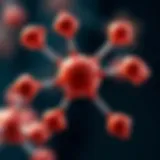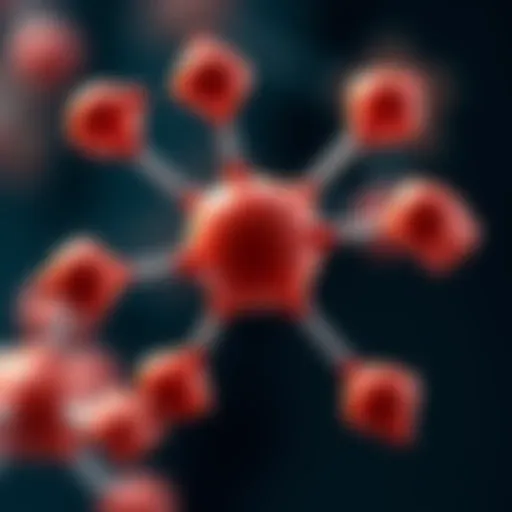Exploring the Versatile Applications of Infrared Technology


Intro
Infrared technology has become an essential aspect in many modern applications. From healthcare to communications, the ability to harness infrared radiation has led to innovative solutions across various fields. Understanding these applications not only involves a look into the technological advancements but also requires an appreciation of the scientific principles underpinning this versatile form of electromagnetic radiation.
Article Overview
Purpose of the Article
This article intends to provide a thorough understanding of infrared applications, elucidating the role of this technology in everyday life and scientific research. By exploring the advancements made in areas like thermography and environmental monitoring, the article aims to clarify how fundamentals of infrared science translate into practical applications. This introduction sets the stage for a discussion that intertwines theory with practice, thereby fostering a deeper appreciation for infrared technology.
Relevance to Multiple Disciplines
Infrared applications span a variety of disciplines, making this topic highly relevant to diverse audiences.
- Healthcare: Infrared thermography helps in diagnosing various medical conditions, such as detecting breast cancer or assessing inflammation.
- Telecommunications: Infrared technology plays a significant role in enabling data transmission in optical fiber networks.
- Environmental Science: Sensors utilizing infrared radiation can monitor gas emissions and detect changes in climate.
- Astronomy: Infrared telescopes allow scientists to observe celestial bodies that are otherwise hidden from view.
These examples illustrate just a few ways infrared technology is embedded in our daily lives. The cross-disciplinary nature of infrared applications highlights the importance of understanding this technology in the broader context of science and engineering.
Research Background
Historical Context
The discovery of infrared radiation dates back to the early 19th century when William Herschel first identified it. Since then, there has been a continuous evolution in the understanding and utilization of infrared technology. Initial applications focused on basic thermal imaging in the military and scientific research, but advancements in materials and sensor technology have vastly expanded its capabilities.
Key Concepts and Definitions
To grasp the applications of infrared technology, it is crucial to understand several key concepts:
- Infrared Radiation: A type of electromagnetic radiation with wavelengths longer than visible light, typically between 700 nm and 1 mm.
- Thermography: A process that uses infrared cameras to create images based on thermal energy emitted by objects.
- Spectroscopy: A technique that exploits the interaction of infrared radiation with matter to identify chemical compositions.
- Optical Fiber: A medium that uses infrared light for signal transmission, crucial in telecommunication networks.
Understanding these fundamental concepts forms the bedrock for exploring the diverse applications and future trends of infrared technology.
Prelims to Infrared Technology
Infrared technology serves as a cornerstone in numerous fields ranging from healthcare to communication. Understanding its importance leads to enhanced applications that benefit society in various ways. In this section, we will explore what infrared technology is, how it developed over time, and its application relevance in our daily lives.
Definition and Overview
Infrared technology refers to the use of infrared radiation, which is located just beyond the visible spectrum of light. It generally operates within wavelengths ranging from about 700 nanometers to 1 millimeter. The technology has diverse applications due to its ability to transfer heat energy effectively. Its most notable uses include thermography, communication, and environmental monitoring.
Users can benefit from infrared technology by enhancing energy efficiency, improving safety, and optimizing data transmission. These advantages make it an essential area of focus for researchers and professionals.
Historical Development
The journey of infrared technology began in the early 19th century with Sir William Herschel's discovery of infrared radiation. Herschel used a prism to analyze sunlight and noticed an increase in temperature beyond the red spectrum, marking the first significant foray into the understanding of infrared.
As technology advanced, the potential of infrared applications became clearer. In the 20th century, significant innovations occurred, particularly in thermography and remote sensing. The military was among the early adopters of infrared imaging for night vision capabilities. In the following decades, applications expanded to industrial inspections, environmental monitoring, and health-related diagnostics, reflecting an evolving understanding of infrared's capabilities.
Infrared technology has transformed our approach to various fields, making it essential for modern scientific pursuits and practical applications.
Infrared technology has transformed our approach to various fields, making it essential for modern scientific pursuits and practical applications.
Recognizing the historical context enriches our comprehension of the current advancements in infrared applications, setting the stage for more in-depth discussions later in this article.
The Science Behind Infrared Radiation
Understanding the science behind infrared radiation is fundamental to grasping its applications and significance in various fields. Infrared radiation plays a crucial role in numerous technologies today, from thermography to telecommunications. By examining the properties and behaviors of this form of electromagnetic radiation, one gains insights into how it can be applied effectively across diverse domains.
Electromagnetic Spectrum
The electromagnetic spectrum encompasses all electromagnetic radiation, ranging from radio waves to gamma rays. Infrared radiation resides between visible light and microwave radiation within this spectrum. It is characterized by wavelengths longer than visible light, typically from 700 nanometers to 1 millimeter.
The importance of infrared radiation in the electromagnetic spectrum cannot be overstated. This range is responsible for a variety of crucial applications such as:
- Thermal imaging: Detecting heat emitted by objects.
- Remote sensing: Monitoring environmental changes.
- Communication technologies: Enabling data transfer.
By focusing on infrared within the spectrum, researchers, and professionals can develop innovative solutions that utilize the unique properties of this radiation. Infrared cameras, for instance, capitalize on these wavelengths to create images based on temperature variations, which is vital in many monitoring applications.


Physical Principles of Infrared Radiation
Infrared radiation fundamentally consists of photons that carry electromagnetic energy. These photons have varying energies correlated to their wavelengths. When an object absorbs these photons, its atoms and molecules move, generating heat. This principle explains how infrared radiation is fundamental in thermal energy transfer.
Several key concepts define the physical behavior of infrared radiation:
- Emission and Absorption: All objects emit and absorb infrared radiation based on their temperature. Hotter objects emit more infrared radiation than cooler ones.
- Reflection and Transmission: Infrared waves can be reflected or transmitted by materials, making it essential to choose appropriate materials in infrared applications.
Understanding these principles allows professionals to tailor infrared applications effectively. For example, in building inspections, materials that absorb or reflect infrared radiation differently can provide insights into heat loss and insulation integrity.
"Infrared applications significantly enhance our capability to monitor and analyze the world around us. Understanding the underlying science is crucial for harnessing its full potential."
"Infrared applications significantly enhance our capability to monitor and analyze the world around us. Understanding the underlying science is crucial for harnessing its full potential."
Classification of Infrared Applications
Classifying infrared applications allows for a better understanding of their diverse functionalities and practical implementations. Infrared technology spans various fields, demonstrating its versatility and significance. The classification delves into essential areas such as thermography, remote sensing, and communication technologies. Each category has distinct features that cater to specific needs. This classification is crucial not only for academic and professional research but also for practical applications in everyday life. Understanding these classifications helps in identifying trends, assessing efficiencies, and advancing new solutions in various domains.
Thermography
Thermography is a technique in which thermal imaging cameras visualize heat patterns and temperature variances. It finds numerous applications, notably in medical, industrial, and building inspection sectors.
Medical Applications
In the medical field, thermography aids in patient monitoring. It allows physicians to observe temperature changes, which can indicate inflammation or other medical conditions. A notable characteristic of medical thermographic applications is their non-invasive nature. This approach is beneficial because it eliminates the need for physical probes, reducing patient discomfort. A unique feature is its ability to enhance early diagnosis in some cases. However, medical practitioners must ensure proper training to avoid misinterpretation of thermal images, which can lead to false diagnoses.
Industrial Uses
Industrial thermography is widely used for predictive maintenance. It helps identify potential equipment failures by revealing hotspots in machinery. The efficiency of Industrial uses arises from their ability to operate in dangerous environments, minimizing physical risks to personnel. Thermal imaging can enable companies to save costs associated with unscheduled downtime. Yet, one must consider that reliance on thermography requires specialized software and skilled personnel, adding an initial investment that some operations may find challenging.
Building Inspections
In construction and real estate, thermography is pivotal in conducting building inspections. Inspectors utilize thermal cameras to detect insulation defects, moisture issues, and air leaks. One major advantage is its high detection accuracy, which can uncover issues unseen to the naked eye. This method is increasingly popular as it improves thermal efficiency and reduces utility costs for building owners. On the downside, weather conditions may affect the accuracy of results, requiring inspectors to work under optimal circumstances for reliable readings.
Remote Sensing
Remote sensing encompasses methodologies that gather data about the Earth from a distance. It serves critical purposes in environmental monitoring, agricultural assessment, and disaster management, among others.
Environmental Monitoring
Environmental monitoring using infrared technology helps assess natural resources and climate phenomena. It can measure temperature changes, land use, and vegetation health over time. The key characteristic of employing infrared for environmental applications is its ability to cover large areas rapidly. This makes it an excellent tool for researchers and environmental agencies. A unique aspect is its integration with satellite systems, providing data that supports government and international policies. However, atmospheric interference can sometimes distort results, complicating data accuracy.
Agricultural Assessment
In agriculture, infrared applications provide valuable insights for crop health assessment. Farmers utilize this technology to monitor aerial imagery, which detects plant stress and hydration needs. A critical aspect of agricultural assessment is its capability to enhance yield predictions. By utilizing thermal data, farmers can increase productivity while conserving resources. However, farmers must regularly update their technology to ensure the integration of the latest advancements.
Disaster Management
Disaster management utilizes infrared technology for early warning systems. This application includes detecting wildfires or assessing damage after events like earthquakes. One key characteristic is its ability to operate in harsh conditions. This enables responders to receive vital information quickly. A distinct advantage of infrared in disaster management is providing real-time data, which can inform evacuation or relief efforts. Nevertheless, there might be limitations in coverage or response time, depending on the infrastructure in place.
Communication Technologies
Communication technologies encompass various means of transmitting data and signals. Infrared applications in this field include infrared data transmission, consumer electronics, and wireless protocols.
Infrared Data Transmission
Infrared data transmission serves as a method for wireless communication, particularly in devices like remote controls and specific networking applications. A key aspect is its low power requirement, making it ideal for battery-operated devices. This method is beneficial for secure connections since infrared signals are less likely to intercept from long distances. However, the primary disadvantage is its limited range, requiring a direct line of sight for effective functioning.
Consumer Electronics
In consumer electronics, infrared technology greatly enhances user interactivity. Devices like televisions and audio systems often utilize infrared sensors for remote control functionality. The primary characteristic here is the ease of use and accessibility for consumers. This application is widely popular, ensuring users can control devices efficiently from a distance. However, potential vulnerabilities exist in terms of security, as infrared can be susceptible to hacking if proper safeguards are not implemented.
Wireless Protocols
Wireless protocols based on infrared provide a method for data exchange among devices. This technology supports communications among various gadgets without the need for cables. A significant benefit is the reduced physical clutter, streamlining the user experience. Infrared protocols are seen as a reliable option in devices where security and energy efficiency are paramount. However, their limitations in distance and obstacle penetration might present challenges, especially in more complex environments.
The classification of infrared applications not only enhances understanding but also stimulates advancements in research and technology. It allows stakeholders to better leverage the full potential of infrared technology across sectors.
The classification of infrared applications not only enhances understanding but also stimulates advancements in research and technology. It allows stakeholders to better leverage the full potential of infrared technology across sectors.


Infrared Apps in Professional Settings
Infrared applications in professional settings hold significant relevance in enhancing operational efficiency and improving outcomes across various fields. The advent of these technologies has paved the way for innovative solutions, specifically in healthcare and industrial sectors. An understanding of their applications and benefits is essential for organizations aiming to leverage infrared technology effectively.
Applications in Healthcare
Patient Monitoring
Patient monitoring is a key application of infrared technology in healthcare. This aspect involves the use of infrared sensors to track vital signs without direct contact. The primary characteristic of patient monitoring is its non-invasive nature. This feature shows a vital benefit, particularly in critical care scenarios, where constant monitoring is necessary.
By utilizing infrared thermography, healthcare providers can effectively manage patient temperatures and detect anomalies. The unique advantage lies in the ability to provide real-time data, facilitating timely interventions. However, reliance on infrared monitoring may face limitations due to environmental factors affecting the accuracy of readings, which may pose challenges in certain clinical settings.
Therapeutic Uses
Therapeutic uses of infrared technology contribute substantially to pain management and rehabilitation. This application involves infrared light therapy, which promotes healing and reduces inflammation. One notable characteristic of this therapeutic approach is its depth of penetration into tissues, which aids in cellular regeneration.
Infrared therapy is recognized for its efficiency in treating muscle soreness and joint pain. The unique feature of this application is the ability to provide relief without the need for pharmaceuticals, making it a popular choice among patients seeking holistic treatment options. However, some individuals might find it less effective for severe cases, and contraindications may limit its use.
Industrial Applications
Predictive Maintenance
Predictive maintenance represents a crucial aspect of infrared technology in industrial settings. This application uses infrared cameras to identify thermal anomalies in equipment. The key characteristic is its proactive approach to maintenance, which allows for early detection of equipment failures before they lead to costly breakdowns.
By implementing predictive maintenance, organizations can minimize downtime and extend equipment life. The unique advantage here is the reduction in maintenance costs, as repairs become more manageable and less frequent. On the downside, initial setup costs for infrared systems may be high, and the need for trained personnel can increase operational complexity.
Quality Control
Quality control is another significant application of infrared technology in industries. Infrared inspection is utilized to ensure product integrity and operational efficiency. This application is characterized by its ability to rapidly assess the quality of a product without direct contact.
Through thermal imaging, manufacturers can detect defects early in the production process. The unique feature of this application is its capability to evaluate large areas quickly and accurately, ensuring consistency across products. However, some limitations exist regarding the interpretation of thermal data, which may require expertise to prevent misdiagnoses.
Through these applications, infrared technology proves indispensable in both healthcare and industrial domains. Understanding their roles and benefits contributes to informed decision-making that enhances both productivity and patient outcomes.
User-Focused Infrared Applications
User-focused infrared applications represent a significant advancement in how individuals interact with and benefit from infrared technology. This domain directly addresses practical and personal needs, making infrared solutions accessible in everyday settings. The essence of this focus is to enhance convenience, comfort, and health through innovative uses of infrared technology.
Home Automation
Home automation stands out as a flagship application of infrared technologies. This category encompasses systems that control various home functions through infrared signaling. Devices such as smart thermostats, lighting systems, and security cameras use infrared sensors to enhance user experience.
Key benefits of home automation include efficiency and energy conservation. For instance, a smart thermostat can adjust heating and cooling schedules based on occupancy. This not only optimizes energy use but also reduces costs. Security systems equipped with infrared technology offer night vision capabilities, allowing homeowners to monitor their properties in low-light conditions effectively.
Considerations for implementing these systems involve compatibility and installation. Many smart home devices can integrate seamlessly with existing setups. However, assessing the technical requirements of each device is crucial for maximizing functionality.
"Home automation with infrared technology provides users not just control but also peace of mind and enhanced efficiency in daily living."
"Home automation with infrared technology provides users not just control but also peace of mind and enhanced efficiency in daily living."
Personal Health Monitoring
Personal health monitoring is another vital area where infrared applications shine. Devices such as infrared thermometers and fitness trackers utilize infrared technology to monitor various health metrics. These tools enable users to track body temperature, heart rate, and other vital signs with great accuracy.
The significant advantage of infrared in this context lies in its non-invasive approach. For example, infrared thermometers allow for quick temperature checks without physical contact. This aspect has proven especially useful in public health scenarios, reducing the risk of disease transmission.
As personal health monitoring continues to evolve, factors such as data privacy and accuracy of readings remain crucial. Users must choose reliable devices and be aware of the data protection measures in place. The trend towards wearable technology incorporates infrared sensors more frequently, highlighting the growing importance of personal health management in daily life.
In summary, user-focused infrared applications play a pivotal role in increasing the quality of life through technology. From streamlining home management to empowering health monitoring, the implications of these technologies are vast and multifaceted.
The Role of Software in Infrared Applications
Software plays a pivotal role in optimizing the use of infrared technology across various applications. By enhancing the functionality of infrared devices, software transforms raw data into digestible insights, facilitates user interaction, and improves overall performance efficiency. As infrared applications evolve, the demand for sophisticated software solutions has become increasingly critical in fields ranging from healthcare to industrial monitoring. This section examines two significant dimensions of software in infrared applications: data analysis techniques and user interfaces.
Data Analysis Techniques
In infrared applications, data analysis is essential for extracting valuable information from the captured infrared signals. These techniques help in interpreting the nuances of thermal images or spectra, which can be integral in fields such as medical diagnostics or predictive maintenance in industries. Key techniques involve:


- Image Processing: Algorithms that enhance the clarity and detail of infrared images, making it easier to identify anomalies.
- Pattern Recognition: This technique uses machine learning to recognize specific patterns in data, such as detecting heat leaks in buildings or identifying tumors in medical images.
- Statistical Analysis: Often used to assess correlations between different infrared measurements and outcome variables, allowing researchers to draw significant conclusions.
Effective data analysis not only maximizes the utility of the collected data but also plays an essential role in decision making and problem resolution.
Effective data analysis not only maximizes the utility of the collected data but also plays an essential role in decision making and problem resolution.
User Interfaces and User Experience
User interfaces (UIs) and user experience (UX) are crucial in ensuring that operators can effectively leverage infrared technology. A well-designed UI facilitates immediate understanding and interaction with complex systems. Essential aspects include:
- Clarity and Simplicity: Information must be presented clearly. Users often need to navigate through complex datasets quickly, thus, simplicity aids in understanding outcomes without overwhelming details.
- Interactive Elements: Features like zooming in on specific data points, real-time analytics, and visual aids can enhance user engagement and experience.
- Customizable Dashboards: Users benefit from interfaces that allow them to tailor what they see based on their specific needs or preferences, thus streamlining their workflow.
The synergy between data analysis techniques and intuitive UIs provides a foundation for effective decision-making processes in both professional and personal contexts involving infrared technology. As the technology progresses, the collaboration between software development and infrared applications will likely deepen, paving the way for even more innovative solutions.
Future Trends in Infrared Applications
The landscape of infrared applications is continuously evolving. As technology advances, the integration of new methods with existing infrared uses is paramount. This section delves into the anticipated trends that could redefine how infrared technology operates across various sectors.
Emerging Technologies
Emerging technologies often serve as the catalyst for innovation within infrared applications. Some key areas include:
- Nanotechnology: This field enables the manipulation of materials at a molecular scale. It impacts infrared sensors, allowing for superior sensitivity and greater accuracy.
- Quantum Dots: These semiconductor particles can be engineered to absorb and emit specific wavelengths of infrared light. They are expected to enhance imaging systems significantly.
- Machine Learning: The application of machine learning algorithms improves data analysis from infrared imaging systems. It allows for better predictive capabilities in medical diagnostics and industrial applications.
These technologies promise not only to enhance existing systems but also to create entirely new applications. The rise in significance for environmental monitoring and diagnostics will be particularly notable as innovations develop.
Integration with Other Technologies
The seamless integration of infrared technology with other platforms is essential for maximizing its potential. Consider the following aspects:
- Internet of Things (IoT): By incorporating infrared sensors into IoT devices, real-time data can be gathered and analyzed, which improves efficiency in fields such as smart homes and healthcare.
- Artificial Intelligence (AI): The combination of AI with infrared imaging can lead to smarter diagnostic tools in the medical field. AI algorithms can interpret infrared data and identify patterns that might escape human analysis.
- Augmented Reality (AR): Integrating infrared capabilities into AR applications can enhance user experiences, particularly in training and skill development, by providing visual feedback that highlights changes in thermal readings.
Moreover, regulatory frameworks and standards will influence how these integrations unfold. Organizations and manufacturers must stay informed about compliance in the integration process. Emerging technologies will need careful consideration to address these challenges and improve user trust in infrared applications.
The combination of infrared technology with innovative methods signals a future rich in possibilities, shaping domains from industrial processes to personal health monitoring.
The combination of infrared technology with innovative methods signals a future rich in possibilities, shaping domains from industrial processes to personal health monitoring.
Overall, keeping an eye on these trends is essential for professionals and researchers alike. They highlight the dynamic interactions within science and technology that drive infrared applications forward.
Challenges and Limitations in Infrared Applications
Infrared applications have seen significant growth across numerous sectors. However, it is essential to acknowledge the challenges and limitations they face. Addressing these factors is crucial not only for understanding the current technological landscape but also for steering future research and development.
Technical Limitations
One of the primary technical challenges relates to resolution and sensitivity. Infrared sensors and cameras can struggle to capture fine details, especially at long distances. The resolution of thermal images may decrease due to the inherent background noise and interference from other heat sources. This can greatly affect the quality of data acquired, limiting its practical applications in fields like medical thermography, where precision is paramount.
Another significant concern is environmental factors. Infrared radiation can be influenced by atmospheric conditions, such as humidity, fog, or rain. These factors may impact the effectiveness of remote sensing applications. In industrial settings, reflective surfaces can distort thermal images, complicating assessments and inspections. Therefore, technological advancements must focus on minimizing these limitations through more sophisticated sensors and algorithms.
Finally, there is the issue of cost. High-quality infrared devices can be expensive to produce and maintain. This can restrict their accessibility for smaller businesses or research institutions. The development of cost-effective solutions is vital for broadening the adoption of infrared technology.
Regulatory and Ethical Considerations
With the expansion of infrared applications, regulatory and ethical implications have become increasingly relevant. As infrared technology can be used for surveillance purposes, it raises questions about privacy and consent. Unauthorized monitoring may lead to significant ethical dilemmas, necessitating clear regulations to protect individual rights.
Furthermore, the accuracy of data interpretation is crucial in sectors such as healthcare. Misinterpretation of infrared measurements can lead to erroneous conclusions and inappropriate actions. This reality highlights the need for well-defined standards and protocols in data collection and analysis. Regulatory authorities must ensure that industries adhere to these guidelines to maintain the integrity of infrared applications.
In summary, while the promise of infrared technology is profound, it is essential to consider its challenges. Technical constraints can hinder effective data collection and analysis, while regulatory and ethical considerations necessitate thoughtful frameworks to guide its use. Understanding these elements is critical for leveraging the full potential of infrared applications moving forward.
End
The conclusion plays a vital role in synthesizing the extensive discussions presented in this article regarding infrared applications. It provides an opportunity to consolidate key insights and reflect on the implications of these technologies. Infrared technologies have shown significant potential across various fields, from healthcare to industrial applications. This points to their versatility and adaptability in our increasingly tech-driven world.
Summary of Key Insights
Several critical themes emerged throughout the exploration of infrared applications. Notably:
- Diverse Applications: Infrared technology is employed in diverse sectors, including thermography for medical diagnostics, environmental monitoring, and communication technologies. These applications not only enhance efficiency but also improve safety and accuracy in their respective fields.
- Scientific Foundation: A solid understanding of the science behind infrared radiation is essential. The principles of electromagnetic radiation and the physical processes involved are foundational to leveraging the full potential of infrared technology.
- Software Integration: The role of software in analyzing infrared data cannot be overstated. Advanced algorithms and user-friendly interfaces improve the accessibility of infrared technology, making it more valuable to both professionals and laypersons.
- Challenges and Ethical Concerns: Despite its advantages, infrared technology faces technical limitations and regulatory hurdles. Addressing these challenges is crucial for wider adoption and trust in its effectiveness.
Implications for Future Research
Looking ahead, several avenues for future research stand out. Researchers will need to:
- Innovate New Applications: Continued innovation is essential to discover new applications of infrared technology, particularly in emerging fields such as smart cities and personalized healthcare.
- Enhance Data Processing Techniques: As data collected by infrared systems grows exponentially, developing more efficient data processing algorithms will be imperative for real-time applications.
- Interdisciplinary Collaboration: Encouraging collaboration between disciplines can lead to breakthroughs in how infrared technology is utilized. Joining insights from physics, engineering, and software design can drive new developments.
- Address Ethical Concerns: Ethical considerations will need to be at the forefront of any future research. Ensuring privacy and security in infrared applications, especially in personal health monitoring, must be a priority.



